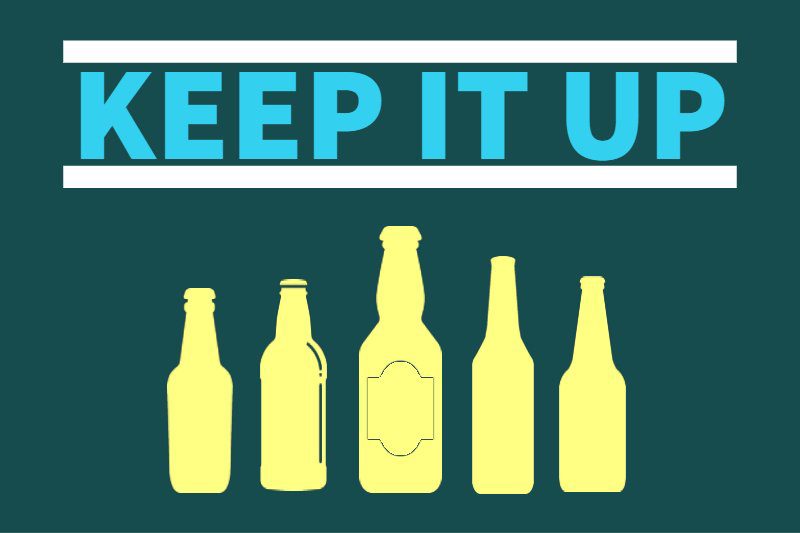Keep Cold; Drink Fresh: The Science of Proper Beer Storage

Fresh Beer Tastes Better
Fresh beer tastes better. Simple, right? A lot goes into making sure the beer you get is as fresh as it was when it left the brewery, or as close to it as possible. Brewers work hard to brew and package the beer to keep it fresh and they trust their distributors and retailers to handle the beer properly until you purchase it. After that, the fate of your beer is in your hands. Take good care of it. A few missteps along the way and the beer you get may not be what the brewery intended, and it’s really not that difficult for that to happen. Unfortunately, the usual break in this chain is the consumer. Not intentionally, of course, but many consumers don’t know how quickly a beer can go “bad” in the right (wrong?) conditions. Fortunately, it’s also not that hard to take the proper steps to keep your beer pristine.
I spoke with Adam Beauchamp, Brewmaster and Co-founder of Creature Comforts Brewing Co. in Athens, GA about what they do to keep beer fresh and what consumers need to do once they get their beer. Creature Comforts has been rigorously testing the quality of their beers since they opened four years ago. Most notably with their flagship IPA, Tropicalia, a balanced and juicy IPA with moderate bitterness. The info below is based on that research and hopefully, it will be helpful in keeping your beer its freshest. We also have some advice from Blake Tyers, Wood Cellar & Specialty Brand Manager at Creature Comforts, on storing your corked bottles properly and his thoughts on long-term storage or cellaring.
When Good Beer Goes Bad
Oxygen, heat, and light are all out to ruin your beer. These saboteurs can work in conjunction to do their dirty work but some can be controlled to slow the impact of others. Fortunately, it’s not that difficult to keep things in check.
Oxygen: Good for Humans, Bad for Beer
One of the biggest enemies in packaged beer is oxygen. The process of packaging beer introduces some oxygen, and this is what brewers try their best to control. Oxygen in beer is measured as Total Dissolved Oxygen (TDO, which measures the molecules in the beer itself) or Total Packaged Oxygen (TPO, which measures the molecules in the beer and the packaging headspace) in parts per billion. Ideally, brewers want this number to be zero, but that’s tough to achieve. Creature Comforts new canning line has the TPO number down to 30 PPB, with the acceptable threshold at 80 PPB. Oxygen in beer can affect shelf stability and cause oxidation. Over time beer will oxidize but this can be slowed with temperature control; more on that later.
Hops aroma and flavor are the most highly impacted characteristics from oxidation. This means those hazy, hop-bomb, tropical IPAs that are all the rage these days are the most susceptible to oxidation damage. Bitterness is not impacted as much by oxidation, although it may be perceived at a higher level due to other flavors being diminished.
The most common flavors associated with oxidation are papery or cardboard-like, similar to a wet box or newspaper. However, oxidation can also present as rotten vegetables, diaper-like, leathery, sherry-like, or bready. Most people do not like oxidation in their beer, but Beauchamp says a few people do actually prefer some oxidized flavor. Weirdos.
Over time, cans offer much more protection from oxidation than bottles but bottles offer more protection initially. The decreased headspace in a bottle means there’s less room for that bit of oxygen that’s hanging out on top to shimmy its way into your beer. The CO2 in beer makes a little safety cloud at the top of your cans and bottles to keep the oxygen in its place. However, over time the sneaky oxygen will get past the CO2 and works its nasty magic on your brew.

Play it Cool
Beer likes to stay cold, and you like your beer to stay cold. You may not want to drink a beer at 32°, but keeping it at that temp until you’re ready to serve it will help it stay its freshest. On the other side of that coin, a beer stored at 85° for just three days will be completely oxidized. If you toss that 6’er in your backseat on a Friday in July and forget about it until Monday it will be about as bad as it’s going to get. Falling in the middle of these extremes, a beer stored at room temperature of 65-70° will stay acceptably fresh for about 30 days. Beauchamp says this is the 3-30-300 Rule. Beers stored for 3 days at 85°, 30 days at 65°, or 300 days at 32° will all taste the same – oxidized. Of course, there are other variables, and it will vary a bit from beer to beer, but if you want a gauge on freshness this is a good guideline. The reason heat impacts beer so strongly is simple thermodynamics. There are many reactions occurring in beer and each one can proceed 2-4x times faster for every increase of 10°C.
To clear up an old myth, cycling beer warm to cold won’t impact quality, provided you’re within acceptable temperature ranges. It’s likely the myth got started because someone left their beer in a hot trunk over the weekend then chilled it and wasn’t happy with the end results. The issue here was the few days at very hot temps, not the cycling of temperatures. Oxidation will occur over time at any temperature so it’s important to note that even when stored at 32° a beer will taste different after a week, two weeks, and a month.
Storage temperature is, by far, the most easily abused aspect of beer storage by consumers. Fortunately, it’s also relatively easy to control. Check your dates on a beer, if the store has it in a floor stack at room temp and it’s a month old you might want to ask them if it was stored cold before being moved to the floor. Of course, they’re likely to think you’re just a pretentious beer nerd, which should be easily cleared up by you spending the next 30 minutes explaining the science behind beer storage temperatures to them.
Don’t Let There be Light
There are various levels of bro-science out there on what causes skunking in beer but there is also real science on what causes it. The actual culprit is light. An extreme simplification of what happens is that UV light interacts with isohumulones (a compound in beer created when hops are boiled) and produces 3-methylbut-2-ene-1-thiol (3-MBT), which has a very similar chemical composition to an actual skunk’s spray.
Cans, of course, provide the most protection from light. For bottles, the color has a huge impact on the susceptibility of a beer to skunking. Brown bottles block nearly all damaging light, however clear, blue, or green bottles offer very little protection. For lower IBU beers in blue or green bottles, the skunking may not be as bad and can provide more of a funkiness than skunkiness. My homebrew club did a blind tasting of a Brett Saison split-packaged in brown and green bottles. One bottle of each was left in indirect sunlight for 6 months. Of the 7 people that tried both beers, all preferred the green bottle version. Tasters said it had more character, funkiness, and depth of flavor. Weirdos.
In certain conditions, it doesn’t take long for skunking to start. The Practical Brewer tells us a bottled beer in bright sun can become light-struck in less the one minute, after a few hours in diffuse daylight, and a few days under normal fluorescent light. If you pour a pint and sit on your back patio on a bright day you may notice some changes before you finish your beer.

Keep it Up
For all cans or capped bottles, store them upright. That little pocket of oxygen will have much less surface area contact with your beer, slowing the rate of oxidation. Storing cans or bottles on their side increases the surface area that’s exposed to oxygen, speeding the oxidation process.
For storage of corked bottles, the experts are divided. Tyers says they condition their beers on the side and move them upright once they deemed them conditioned. Tyers admits they do not have as much data for corked bottles so he leans on the wisdom of the wine industry, specifically pertaining to champagne and sparkling wines. The most popular opinion there is to store these bottles upright as well. For still wines, a cork can dry out over time but with champagne and sparkling wines, the carbonation keeps moisture and pressure in the bottle. Naturally, this would apply to most corked beers as well. Therefore, it’s a safe bet to store all your beer upright, although you will undoubtedly find someone who will tell you otherwise.
For long-term storage or cellaring your beer Tyers advises, “Just don’t do it.” There are very few beers that benefit from long-term aging. Lambic and gueuze are a couple of styles that will age gracefully given the right conditions, which most consumers can’t provide. Cellared beer should be kept around 55°F and away from light. Although you may not get the same levels of oxidation that you would with one of those hazy IPAs, the beer will age faster in warmer conditions. Most brewers have done any necessary aging before they release their beers to the public. Whether that’s through bottle conditioning or barrel-aging. Once a beer is available to the consumer the brewer feels it is ready to drink. Of course, if you’re serious about beer you’re going to ignore this and try it anyhow, the closet full of bottles I have is proof of that. Just make sure to keep them upright, cool, and in the shade.
Keep Cold; Drink Fresh
It’s not just a catchy phrase. Keep Cold; Drink Fresh is solid advice for maximum enjoyment of your beer. It doesn’t take much to keep your beer fresh and ready to party, but it also doesn’t take much to totally ruin it. Keep it cool, keep it away from light, and store it upright – easy stuff. Don’t screw it up.
https://beerguysradio.com/2018/05/11/keep-cold-drink-fresh-science-proper-beer-storage-temperature/https://beerguysradio.com/wp-content/uploads/2018/05/Keep-Cold-Drink-Fresh-2-800x419.jpghttps://beerguysradio.com/wp-content/uploads/2018/05/Keep-Cold-Drink-Fresh-2-150x150.jpgBeer 101Beer ScienceFeaturesaging,beer science,light,oxidation,oxidized,oxygen,skunk,storage,temperatureFresh Beer Tastes Better Fresh beer tastes better. Simple, right? A lot goes into making sure the beer you get is as fresh as it was when it left the brewery, or as close to it as possible. Brewers work hard to brew and package the beer to keep it...Tim DennisTim Dennistgdennis@gmail.comAdministratorCo-Host of the Beer Guys Radio Show. Georgia beer advocate, all around craft beer fan, homebrewer, and troublemaker.Beer Guys Radio Craft Beer Podcast




Leave a Reply